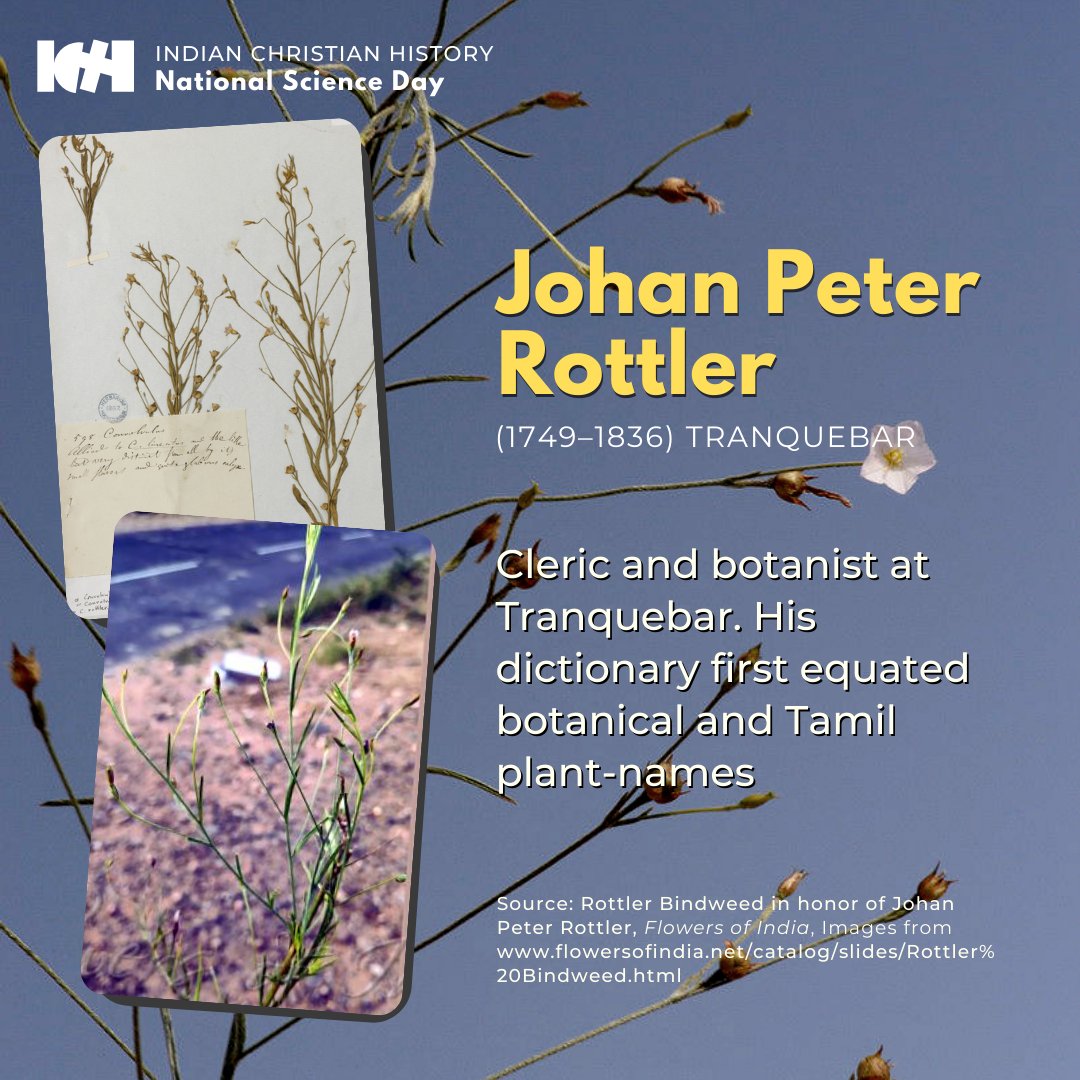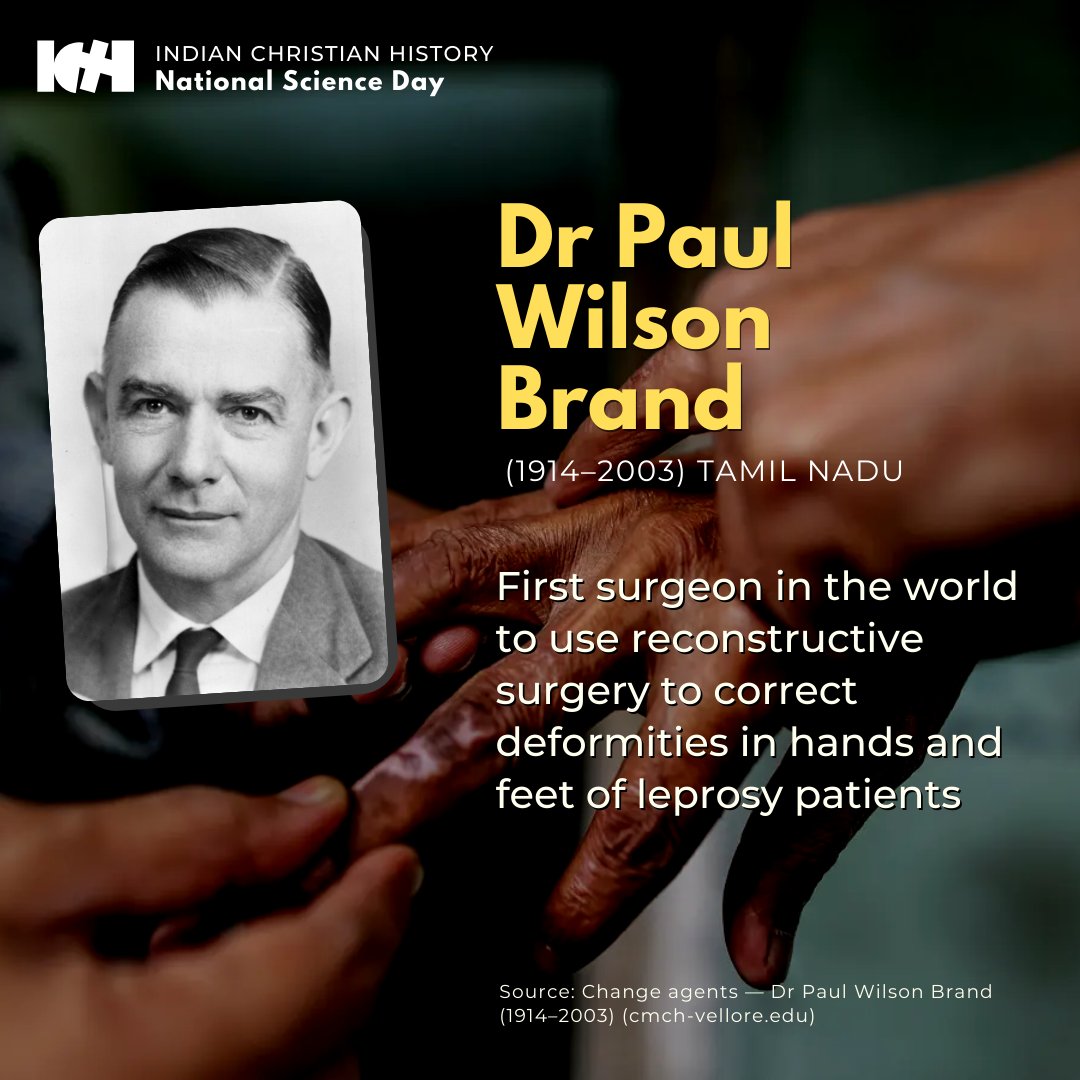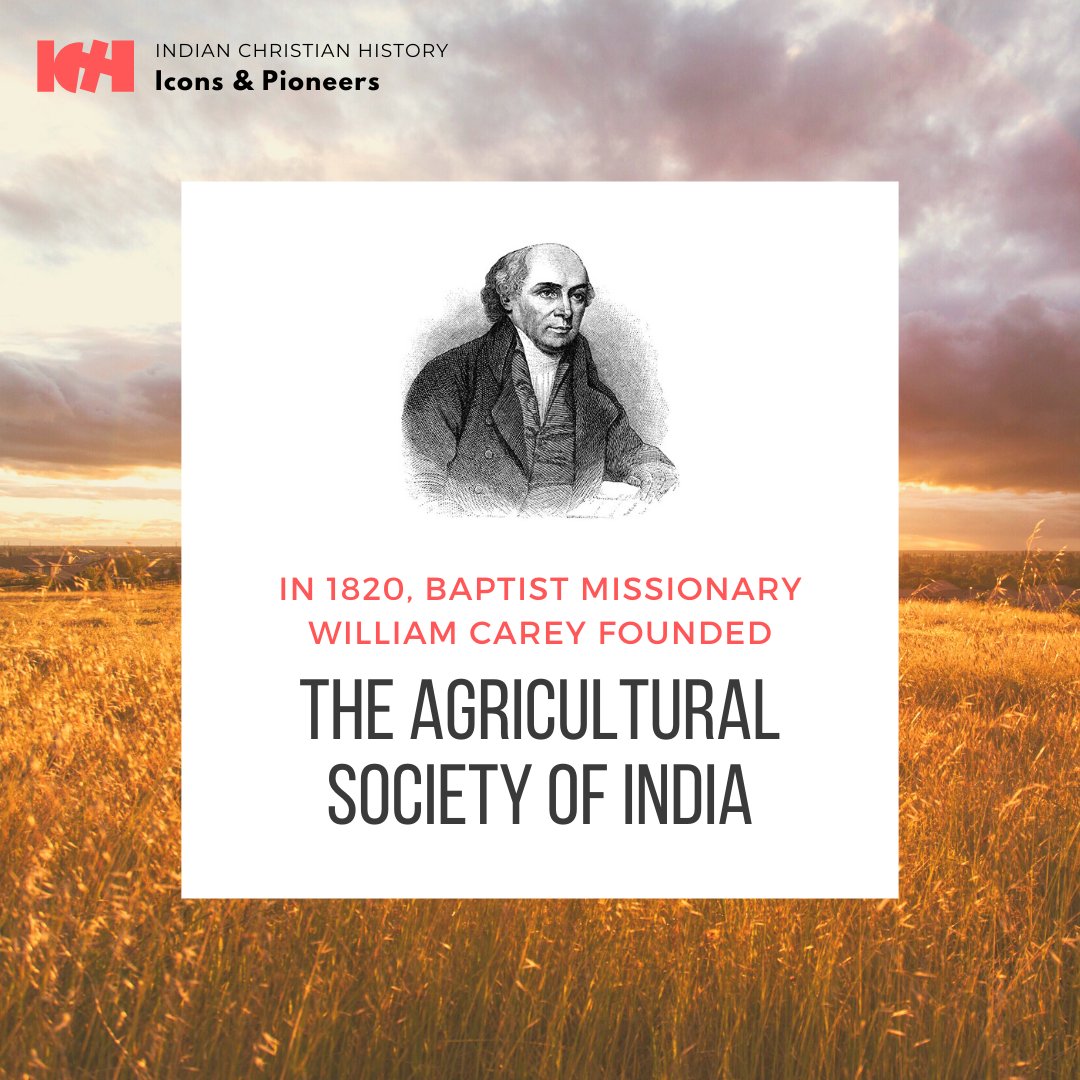
Joseph Tieffenthaler (1710–1785): Missionary who did extensive work in astronomy and geography. Considered the "father of modern Indian geography". Proficient in mathematics, astronomy, geography and natural sciences. #NationalScienceDay 6/51 

Dr Johann Gerhard Koenig (1728–1785): Botanist and physician. Plant genus Koenigia named for him by Linnaeus; also a species of curry-leaf tree Murraya koenigii. #NationalScienceDay 7/51 

Rev. Dr Christoph Samuel John (1747–1813): Naturalist and missionary at Travancore from 1771 until his death. The shrub “John's Balsam”, named after him, is endemic to Southern W. Ghats, found on stream beds in Kerala. #NationalScienceDay 8/51 

Johan Peter Rottler (1749–1836): Cleric and botanist at Tranquebar Mission. His mastery of Tamil led to a dictionary which have the first equatings of botanical and Tamil plant-names. Rottler Bindweed a herb is named in his honour. #NationalScienceDay 9/51 

Benjamin Heyne (1770–1819): Botanist at Tranquebar Mission. A tree species named in his honour, “Heynea Roxb”. Key role in coconut & potato plantation in South India. Published on rock formation and minerals and soil of southern peninsula. #NationalScienceDay 10/51
John Henry Pratt (1809–1871): Mathematician and physicist; Archdeacon of Calcutta. Tried to calculate mass of Himalayas, after Trigonometrical Survey had discrepancies. Developed his own version of theory of isostasy; See Pratt model. #NationalScienceDay 11/51 

Joseph Ciceron (?–1876): Deep interest in life sciences. At his suggestion the Collector formed Kodaikanal Lake in 1863 by damming the valley where three streams flowed. Ciceron introduced pear trees to Kodaikanal. Died at Trichinopoly in 1876. 12/51 #NationalScienceDay 

Stephen Hislop (1817–1863): Geologist, missionary founder of Hislop College. Green mineral Hislopite is named after him. Among his geological discoveries is the fossil reptile, Brachyops laticeps found in his explorations in Nagpur. #NationalScienceDay 13/51 

Heinrich August Jaeschke (1817–1883): Botanist based near Tibetan border at Kailang. The genus Jaeschkea Kurz was named in his honour. Also worked on a Tibetan translation of the Bible and other linguistic works, such as a Tibetan–English dictionary. #NationalScienceDay 14/51 

Carey, Marshman & Ward: Scientific works like Hortus Bengalensis, Roxburgh's Flora Indica came out of Serampore. Following this, Bengal took the lead; between 1868 and 1910, ten journals & magazines in science alone and 47 in technology came from Bengal. #NationalScienceDay 15/51 

Samuel Bacon Fairbank (1822–1898): Lifelong love for natural science, planted gardens wherever he went as an evangelist. Published articles on local birds, plants, reptiles, and fish. Montecincla fairbanki is a plant named after him. #NationalScienceDay 16/51 

Fr Alphonso de Penaranda (1834–1898): Passionate astronomer who brought science to the masses. Taught Tagore during 1875–76 and made a deep impact with his spirit of peace. Tagore dedicated his memoirs to him; his ideal teacher. #NationalScienceDay 17/51 

Eugène Lafont (1837–1908): Belgian priest. Noted scientist and founder of first Scientific Society in India. Key role in persuading Calcutta Univ. to initiate an undergraduate course in science. J. C. Bose, C. V. Raman were deeply indebted to him. #NationalScienceDay 18/51 

Rev. Charles Michie Smith (1854–1922): Interested in meteorology and astronomy, making himself an expert in both. Government Astronomer, Madras, 1891–99; Director of Madras and Kodaikanal Observatories, 1899–1911. #NationalScienceDay 19/51 

William H. Campbell (1859–1910): Missionary entomologist who discovered over 60 new species of moths. Member of Bombay Natural History Society. Started a hospital. Authority on #Telugu; wrote a grammar and three other works in this language. #NationalScienceDay 20/51 

Dr Annie Jaganathan (?–1894): First Indian to have studied medicine in Madras as well as in Britain. Madras Medical College (1883–88) and at Edinburgh (1888). Did triple qualification (medicine, surgery and midwifery). Worked at Cama Hospital, Bombay. #NationalScienceDay 21/51
Mason Vaugh (1874–1978): Missionary agriculturist. Considered the “Father of Agricultural Engineering” in India, forged a full fledged degree in Agricultural Engineering in 1942 which was the first of its kind in Asia. #NationalScienceDay 22/51 

Fr Ferdinand Caius (1877–1944) studied medicinal plants, poisonous reptiles, anti-venomous serums, and organic compounds of mercury. His books are standard reference volumes. Streptomyces caiuseae, a microorganism is named after him #NationalScienceDay 23/51 

Fr Ethelbert Blatter, SJ (1877–1934): Founder of Blatter Herbarium at St. Xavier’s College, Mumbai, he was a plant taxonomist who specialized in plants of Maharashtra. Eight plants have been named after him in recognition of his great work. #NationalScienceDay 24/51 

Georges Foreau (1882–1967): Plant collector. French missionary who made extensive collections of plants, esp. bryophytes, in South India. Based in Sacred Heart College at Shembaganur in Palni Hills. Published two lists of mosses in 1930 and 1961. #NationalScienceDay 25/51
Dr Winfield Dudgeon (1886–1932): A teacher at Ewing Christian College in Allahabad, where he started the first lab course in botany. He was founding president of Indian Botanical Society. One important paper was on "The Ecology of Tehri Garhwal". #NationalScienceDay 26/51 

Isaac Santra (1892–1968) conducted anti-leprosy research work. Padma Shri (1956). Helped Indian govt design model leprosy colonies. Early proponent of chaulmoogra oil as treatment, having encountered it in the Sanskrit medical text Sushruta Samhita. #NationalScienceDay 27/51 

Robert Fleming: Missionary & ornithologist in north India and Nepal. With his son co-authored a book on birds of Nepal; it listed 787 species and soon made its mark as a classic. Also interested in ferns; gathered a number of specimens in Uttarakhand. #NationalScienceDay 28/51
Ruby Jesudasen Manikam (1899–?): In 1926, she was the first international student graduating from New Jersey College for Women; Bachelor of Science. Also MA in bacteriology and public health at Univ. of Pennsylvania. Worked on Public Health in India. #NationalScienceDay 29/51 

Professor Walter F. Kibble: Popular math & statistics teacher at Madras Christian College. Responsible for creation of a sundial on MCC campus. His son Tom Kibble was among 6 researchers whose work led to discovery of Higgs Boson in 2012 (Nobel Prize). #NationalScienceDay 30/51
Dr K. T. Jacob: Pioneering Plant-geneticist. Carried on the work of Sir Jagadish Chandra Bose at the Bose Institute. He studied the morphology and chromosome characters of seven types of Asiatic cotton, and classified them into seven groups. #NationalScienceDay 31/51
Austin Manindra Nath Ghosh (1902–1961): Eminent geologist & a founder of the oil industry in public sector. Credited with discovery of coal in Western Sikkim. Discovered new localities for fossilized remains of dinosaurs in Jabalpur and in Rewa #NationalScienceDay 32/51 

Hermenegild Santapau (1903-1970): Botanist, known for his taxonomical research on Indian flora. Collected some 100,000 specimens. Birbal Sahni Gold Medal (1964); Padma Shri (1967); President, Indian Botanical Society (1955). #NationalScienceDay 33/51 

Dr Jacob Chandy (1910–2007): Initiated the first neurosurgical training program in India at the Christian Medical College, Vellore, in 1957. His trainees and their students have helped to establish neurosurgery all over India. #NationalScienceDay 34/51 

Dr Paul Wilson Brand (1914–2003): First surgeon in the world to use reconstructive surgery—in the late 1940s—to straighten crooked bones in leprosy patients. His wife, Dr Margaret Brand, focussed on research to prevent blindness in people with leprosy. #NationalScienceDay 35/51 

Joseph Pallithanam, SJ (1915–84), collected thousands of plant specimens with the idea of promoting biodiversity. His Pocket Flora of the Sirumalai Hills is a useful guide to botanists and tourists. #NationalScienceDay 36/51 

Dr Thomas Thomas or T. Thomas (1917–1998): The first Indian cardio-thoracic surgeon. He was the first surgeon in South Asia to do a mitral valvulotomy. #NationalScienceDay 37/51
Dr Anna Modayil Mani (1918–2001): Physicist & meteorologist who invented over 100 gadgets that measured weather, solar radiation & more. Her contributions changed the way India gauges weather; she helped lay the ground for harnessing solar & wind power #NationalScienceDay 38/51 

Dr KP Abraham (1920–2011): Pioneer in extractive metallurgy. Active part in starting the materials engineering degree course in chemical & physical metallurgy at IISc. Published 100 technical papers; co-authored textbook Extraction of Nonferrous Metals. #NationalScienceDay 39/51 

Dr Charles Kamalam Job (1923–2012): Eminent leprosy scientist. Was the earliest to use the electron microscope in India, particularly for leprosy research; installed at CMC, Vellore in 1963. Awarded Damien-Dutton Award in 1993, by Bill Clinton. #NationalScienceDay 40/51 

Dr Ranjan Roy Daniel (1923–2005): Pioneered exploration of the far infrared waveband of the electromagnetic spectrum for astronomical studies in India. Padma Bhushan (1992). Worked in the area of cosmic rays with Homi J. Bhabha. #NationalScienceDay 41/51 

Hermann Bacher, SJ (b. 1925), established the Social Centre (Ahmednagar), in 1996 to promote sustainable development among communities in drought-prone Ahmednagar. Initiated schemes to reserve sufficient volume of water for both drinking and irrigation. #NationalScienceDay 42/51 

Appaji G. Sathyanesan (1926–2013): Leading zoologist & fish scientist. Recognized effects of water pollution on fish life and reproduction. Fellow of Indian National Science Academy. Eminent Zoologist Medal by Zoological Society of India in 1988 #NationalScienceDay 43/51 

K. E. Joseph, SJ (1926–99), started Bihar Water Development Society in the 1970s and assisting local communities of South Bihar in digging wells and tube wells. #NationalScienceDay 44/51
Cecil Saldanha (1926–2002) compiled a compact work covering the botanically unexplored area of the Western Ghats of peninsular India. In his book, 1,700 species of vascular plants have been reported. It has 132 original drawings & twenty colour plates #NationalScienceDay 45/51 

Jivanayakam C. Daniel (1927-2011): Naturalist, and the author of several acclaimed books on birds, mammals, and reptiles. A species of lizard is named after him; Bronchocela danieli. Curator of Bombay Natural History Society. #NationalScienceDay 46/51 

Koyapillil Mathai Mathew (1930–2004) Indira Gandhi Paryavaran Puraskar for 2002 for environmental protection. Best Teacher Award of Tamil Nadu in 1989. A new species, Strobilanthes matthewiana named in his honour. #NationalScienceDay 47/51 

Candanat John Dominic (1930–2008): Leading scientist; worked in avian endocrinology; Double Ph.D.; published >250 research papers. Authority on mammalian reproductive pheromones; Ph.D. from Cambridge (1965). Over four decades in Banaras Hindu University #NationalScienceDay 48/51 

Chris Wigglesworth (1938–2020): Theologian, geologist led water development projects in Maharashtra for villages hit by famine. Built percolation tanks to retain rain. His team designed a low-cost hand pump; now world’s most widely used – India Mark II. #NationalScienceDay 49/51 

Visuvasam Manickam (1944–2012): Carried out extensive fieldwork on Pteridophytes of Western Ghats from 1969 on. Collected ~2,500 pteridophytes. Documented conscientiously, providing numbers & details, something no other cytotaxonomists were doing then. #NationalScienceDay 50/51 

Over the doors of the Cavendish Laboratory in Cambridge we find these words from the Bible:"The works of the Lord are great, sought out by all who have pleasure in them" (Psalm 111: 2). The implications for the scientists are obvious. #NationalScienceDay #NationalScienceDay2021 

• • •
Missing some Tweet in this thread? You can try to
force a refresh





